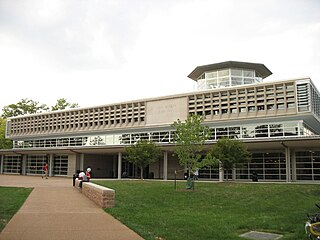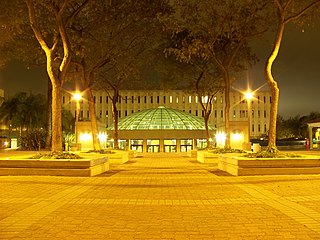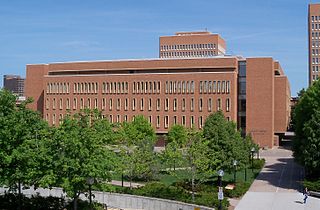
Stanford University, officially Leland Stanford Junior University, is a private research university located in Stanford, California. Stanford was founded in 1885 by Leland and Jane Stanford in memory of their only child, Leland Stanford Jr., who had died of typhoid fever at age 15 the previous year. Stanford was a U.S. senator and former governor of California who made his fortune as a railroad tycoon. The school admitted its first students on October 1, 1891, as a coeducational and non-denominational institution.

The University of Kentucky is a public land-grant research university in Lexington, Kentucky. Founded in 1865 by John Bryan Bowman as the Agricultural and Mechanical College of Kentucky, the university is one of the state's two land-grant universities and the institution with the highest enrollment in the state, with 30,545 students as of fall 2019.
The Hoover Institution is a conservative American public policy think tank and research institution that promotes personal and economic liberty, free enterprise, and limited government. Located in Stanford, California, it began as a library founded in 1919 by Stanford alumnus Herbert Hoover, before he became President of the United States. The library, known as the Hoover Institution Library and Archives, houses multiple archives related to Hoover, World War I, World War II, and other world-historical events.

Jane Elizabeth Lathrop Stanford was a co-founder of Stanford University in 1885 along with her husband, Leland Stanford, as a memorial to their only child, Leland Stanford Jr., who died in 1884 at the age of 15. After her husband's death in 1893, she funded and operated the university almost single-handedly until her unsolved murder by poisoning in 1905.

The University of Louisville (UofL) is a public research university in Louisville, Kentucky. It is part of the Kentucky state university system. When founded in 1798, it was the first city-owned public university in the United States and one of the first universities chartered west of the Allegheny Mountains. The university is mandated by the Kentucky General Assembly to be a "Preeminent Metropolitan Research University". The university enrolls students from 118 of 120 Kentucky counties, all 50 U.S. states, and 116 countries around the world.

The Cecil H. Green Library is the main library on the Stanford University campus and is part of the SUL system. It is named for Cecil H. Green.

The Ronald Reagan Presidential Library is the repository of presidential records from the administration of Ronald Reagan, the 40th President of the United States, and the burial place of the President and First Lady, Nancy Reagan. It is the largest of the 13 federally operated presidential libraries, containing millions of documents, photographs, films and tapes. There is a permanent exhibit covering the President's life, as well as memorabilia such as Air Force One, the aircraft personally used by the president, and a section of masonry from the Berlin Wall. In 2007, thousands of artifacts were reported missing, and poor record-keeping as well as a breakdown in security software were blamed.
The University of California operates the largest academic library system in the world. It manages more than 40.8 million print volumes in 100 libraries on ten campuses. The purpose of these libraries is to assist research and instruction on the University of California campuses. While each campus library is separate, they share facilities for storage, computerized indexing, digital libraries and management. For example, each campus maintains its own computerized library catalog and simultaneously participates in the systemwide union catalog, MELVYL.

Washington University Libraries is the library system of Washington University in St. Louis. The system includes 12 libraries and over 5.5 million volumes. The John M. Olin Library is the central library.

The library system of the University of California, Los Angeles, is one of the largest academic research libraries in North America, with a collection of over nine million books and 70,000 serials. The UCLA Library System is spread over 12 libraries, 12 other archives, reading rooms, research centers and the Southern Regional Library Facility, which serves as a remote storage facility for southern UC campuses. It is among the ten largest academic research library systems in the United States, and its annual budget allocates $10 million for the procurement of digital and print material. It is a Federal Depository Library, California State Depository Library, and United Nations Depository Library.

The J. Henry Meyer Memorial Library was a library at Stanford University in California. It was dedicated on December 2, 1966. In 2007, a seismic assessment identified $45 million in required retrofits, more than the cost of a new library elsewhere on campus. Consequently, the library was designated for closure and a new design was accepted featuring a public open space area at the site. The library closed permanently on August 22, 2014, and was demolished during the months of February and March, 2015.

Vernadsky National Library of Ukraine, VNLU is the main academic library and main scientific information centre in Ukraine, one of the world's largest national libraries. Its main building is located in the capital of the country – Kyiv, Demiivka neighborhood.

Malcolm A. Love Library, opened in 1971, is the primary, central academic library serving multiple campuses of San Diego State University (SDSU) in Southern California and Northern Baja California, Mexico Located on the Montezuma Mesa in the College Area of San Diego, California, the Malcom A. Love Library underwent a major expansion to improve Library & Information Access for students institution-wide with construction of the Manchester Hall addition including a spectacular glass enclosed atrium to serve as the new entrance gateway for the University Library. The iconic design and architecture of the new glass and steel enclosed lobby, and its stated purpose, has earned the entire complex the reference The Info Dome.

Stanford Medicine traces its history back to 1858 when Elias Samuel Cooper, a physician in San Francisco, California, founded the first medical school in the Western United States. That school went through many changes, including a change of name to Cooper Medical College, a takeover by Stanford University in 1908, and a move from San Francisco to the Stanford campus near Palo Alto, California in 1959.
Laurence William Lane Jr. was an American magazine publisher, diplomat, and philanthropist.

The Hoover Institution Library and Archives is a research center and archival repository located at Stanford University, near Palo Alto, California in the United States of America. Built around a collection amassed by Stanford graduate Herbert Hoover prior to his becoming President of the United States, the Hoover Library and Archives is largely dedicated to the world history of the 20th and 21st centuries. It includes one of the largest collections of political posters in the world.

The University of Minnesota Libraries is the library system of the University of Minnesota Twin Cities campus, operating at 13 facilities in and around Minneapolis–Saint Paul. It has over 7 million volumes and 119,000 serial titles that are collected, maintained and made accessible. The system is the 17th largest academic library in North America and the 20th largest library in the United States. While the system's primary mission is to serve faculty, staff and students, because the University is a public institution of higher education its libraries are also open to the public.

Levi Cooper Lane was an American physician and surgeon. He established the Cooper Medical College, forerunner to the Stanford University School of Medicine, as well as laying the groundwork for Stanford's medical library and the Stanford School of Nursing. The University's medical library is still named Lane Medical Library in his honor.
Lane Medical Library & Knowledge Management Center is the library of the Stanford University School of Medicine at Stanford University, near Palo Alto, California. Its mission is to "enable biomedical discovery by connecting people with knowledge". It is located on campus adjacent to Stanford Hospital and Clinics. In addition to books, journals and documents for medical research and the teaching and practice of medicine, Lane Library houses a significant collection of material relating to the history of medicine. The library also provides specialized search capabilities, classes and tutorials, writing and grant support, and group and individual study spaces.
This is the history of Stanford University.



















